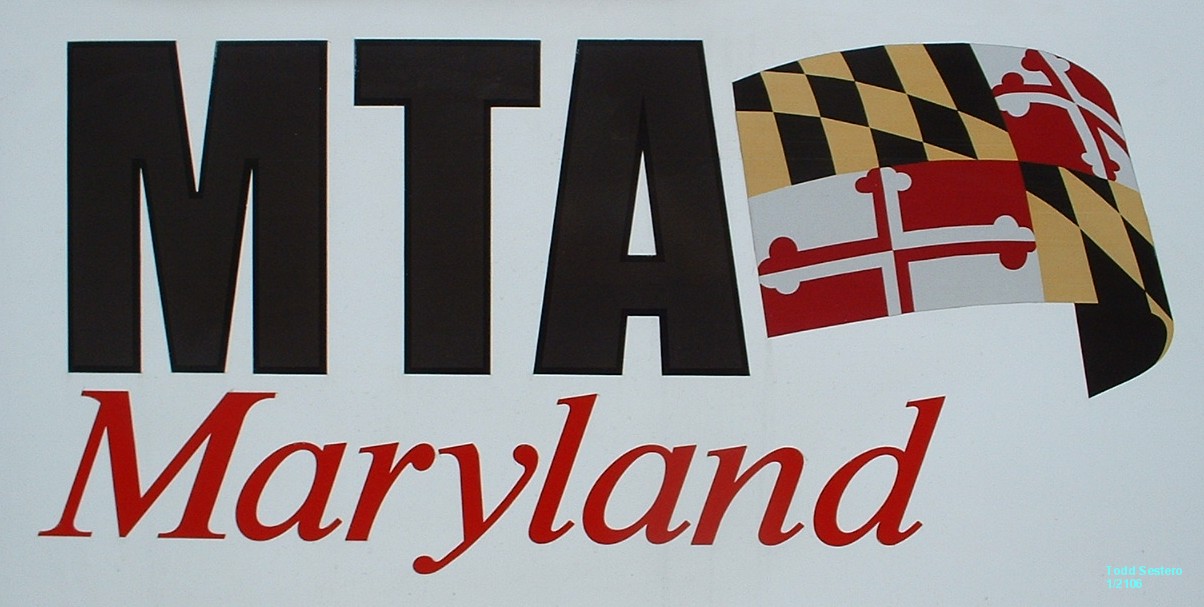
Signals of the Baltimore
Light Rail System
RAILROAD SIGNALS of the U.S.

Signals of
the Baltimore
Light Rail System
This section covers signals of the Baltimore Light Rail system.
The Baltimore Light Rail System uses a variety of signal styles to convey information to the operators. Depending on the type of information they are trying to convey, and where they are, they might use "standard" 3 color light signal, a position bar signal (modified "hand/man" type signal with semaphore bars), or Pennsy style dwarf position lights. Also in use are horn, bell, and hand signals. All references come from an 8/18/94 manual given to me when I came onboard in January of 1995. Comments I have added are in green.
Color Light Signals
The standard three color light signals are used in ABS territory, generally, north of the North Avenue station, and south of Camden station. You have to notice the departure from standard railroad practice, with green being on the bottom, like standard auto traffic signals. When I worked at the MTA, the reason I heard for this was, "It's what the operators are used to, and we don't want to confuse them". After all, the light and heavy rail operators are bus drivers who have enough seniority to "pick" into those divisions, and they are generally not the brightest. With that said, only two signals convey any sort of speed information: clear and restricting. Now that the Light Rail runs with ATC, the clear aspect doesn't have a whole lot of meaning, since the train automatically limits itself to the MAS. The aspects are as follows:

 Rule 4.4.1
Rule 4.4.1
Aspect: Red
Name: Stop Signal
Indication: Stop
This spot is where the track used to go to double track in Riderwood, kinda under the 695 Beltway - looking in the direction of the picture, north. During the winter, I can see the two signals at this location from my house.
There is also a crossover here, that's why there is a call button box in front of the signal. The sister crossover is on the other side of the highway overpass.
A sub-station is
also at this location, on the other side of the R-O-W.
 Rule 4.4.2
Rule 4.4.2
Aspect: Yellow
Name: Approach
Indication: Proceed, prepared to stop at the next signal

 Rule 4.4.3
Rule 4.4.3
Aspect: Green
Name: Clear
Indication: Proceed at MAS
 Rule 4.4.4
Rule 4.4.4
Aspect: Red over Yellow
Name: Restricting
Indication: Proceed at Restricted Speed until entire
train has passed a signal displaying a more favorable aspect.
 (Note: there were two signals that conveyed
Restricting, both were southbound signals located next to the light rail shops
at North Avenue, for traffic going into North Avenue.
(Note: there were two signals that conveyed
Restricting, both were southbound signals located next to the light rail shops
at North Avenue, for traffic going into North Avenue.
On a visit to the shops over the summer of 2005, I noticed the southbound signal on the northbound side was gone, probably as a result of the double tracking project, where trains would only have to be on "the other side" in the event of an emergency.
This is the lone signal remaining that displays Restricting. Notice how the signal is mounted to the top of the wall because of the tight clearance thru this section.... the shops are to the right.
This picture is crummy because it is shot thru two pieces of glass.
 Rule 4.4.5
Rule 4.4.5
Aspect: Red over Lunar "S"
(Lunar signal with a black
"S")
Name: Conrail Restricting
Diverging
Indication: Switch lined for Conrail Branch.
Conrail trains or engines proceed at restricted speed. CLRL Trains: Stop,
call Light Rail Control for instructions.
(Note: these signals were supposed to be at Conrail interlocking at signal S122-6, and Woodberry Interlocking signals S178-2 and S178-4). I never did see them in use.
Train Control (excerpt from the above mentioned manual)
Automatic Block Signals (ABS) limits on the North Line are between a point about 700 feet north of the North Avenue station and the Timonium station. South Line limits are between Camden station and the Dorsey Terminal. Limits are identified by wayside signs on the right-of-way and listed in the schedule. Each interlocking in ABS territory has a home signal for each track and approach signals for the normal direction of traffic. There are intermediate signals at the block boundaries on the single track and on the normal direction of traffic in the double track. The signals are three-color lighted mainline railroad signals mounted on masts with concrete foundations.
The signal aspects are controlled by (1) track circuits providing continuous train detection, (2) route setups at the power operated interlocking, (3) electric locks and switch point controllers on freight sidings and hand-throw point controllers on freight sidings and hand-throw cross-overs, and (4) derails, installed on selected freight sidings. Safe train movements are assured by vital relay logic in the wayside signal equipment housings. Trip stops are installed at the normal approaches to interlocking which will invoke a non-retrievable emergency stop should a train run past the red home signal.
Notes to the above:
Needless to say, those familiar with the system will note that the above description is dated. In the late 90's before I left, they had completed the extension to Hunt Valley, and the braches to the airport and Penn Station. In 2004, double tracking of the south section was completed, and by November 1st, 2005, double tracking was complete on the north end to Timonium.
Because of two accidents of trains coming into BWI Airport during 2002, the MTA put into place a really dumb method of speed control, using a series of switches the operators had to actuate as they crawled into the station. If one of the switches was missed, or they were sequenced to quickly, the trip stops would be activated, bringing the train to a halt.
With the double tracking project, came ATP (automatic train protection), which has done away with the trip stops at interlocking points (crossovers and single to double track points). I haven't been down to BWI Airport lately to see if they have replaced the manual train control with ATP.
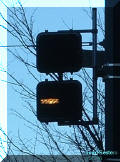
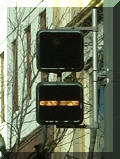
 Rule 4.5.1
Rule 4.5.1
Aspect: Horizontal bar
illuminated
Name: Stop
Indication: Stop
(Left picture shows what happens when one of the bulbs burn out)
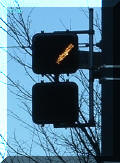 Rule 4.5.2
Rule 4.5.2
Aspect: Diagonal bar illuminated
Name: Caution
Indication: Sound bell and proceed on sight
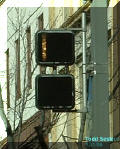 Rule 4.5.3
Rule 4.5.3
Aspect: Vertical bar illuminated
Name: Proceed
Indication: Sound bell and proceed on sight
All pictures taken at Howard St.
and Mulberry St.
(Note: A flashing aspect for any
of the three above aspects indicates a failure. Contact Light Rail Control
for instructions.)
Trackside Indicators
This category covers the remainder of the signals on the Light Rail System.
 Pennsy Style Dwarf Position Lights
Pennsy Style Dwarf Position Lights
 Rule 4.6.1
Rule 4.6.1
Aspect: 2 Horizontal lights
illuminated
Name: Route
Indicator - Stop
Indication: Stop, Switch not aligned for forward
movement
This signal is at North Avenue,
on the northbound track. Sitting high atop a pole, it's purpose is to
inform the operator if the switch ahead is aligned to go straight or diverge
into the yard. This signal indicates the operator can not proceed, either
because the switch is "in between", or, in the case of the northbound signal at
Mt. Royal, a southbound train is coming "out of the hole" at Penn Station, which
will be crossing the northbound track to get into Mt Royal.
Rule 4.6.2
Aspect: 2 Diagonal lights
illuminated
Name: Route
Indicator - Diverging
Indication: Proceed on sight through turnout (diverging)
route
 Rule 4.6.3
Rule 4.6.3
Aspect: 2 Vertical lights
illuminated
Name: Route
Indicator - Straight
Indication: Proceed on sight, on through route




This signal is at Camden Yards, on the southbound track, prior to coming into
the station. The signal indicates the switch is aligned for a straight
move. If it was on the diagonal, the switch would be aligned for the
pocket track.
 Crossing Gate Indicator Lights
Crossing Gate Indicator Lights
Rule 4.6.6
Aspect: Flashing Lunar
Name: Crossing Gate
Indicator
Indication: Proceed. Crossing gate activated.
Be prepared to stop at grade crossing.
Rule 4.6.7
Aspect: Solid Lunar
Name: Crossing Gate
Indicator
Indication: Proceed. Crossing gate in horizontal
position.
To my knowledge, this signal was
never used.
Rule 4.6.4
Aspect: Vertical Arrow
illuminated
Name: Route Selector
Indicator
Indication: Occupy track circuit and proceed - Straight
track alignment
Rule 4.6.5
Aspect: Horizontal Arrow
illuminated
Name: Route Selector
Indicator
Indication: Occupy track circuit and proceed - Diverging
track alignment
4.1.1
a. ooooo
(a succession of short sounds). To be used when an emergency exists,
warning to persons on or about the track, or approaching a train stopped on
adjacent track.
b.
o
Approaching highway grade
crossings unless otherwise designated
(used mostly at the yard entrance
crossing).
c.
-- -- o --
Approaching designated grade crossings
(most of them).
d. oo
Answer to any hand signal. Before moving forward in yard or within yard
limits.
e. ooo
Before moving backward.
4.1.2
Unnecessary or excessive use of the horn in prohibited.
(Note: When I was there, some modifications were made to the above rules. Because of neighborhood pressure, they only blow the horn once at Bellona Ave. in Lutherville (freights still blow normally). The horn was not used in the yard unless an emergency was iminent (like when an MOW truck didn't see me coming out of the shop from 4N and almost hit me).
4.2.1
(The)
Vehicle bell shall be used:
a. To acknowledge a hand signal (this rule was never enforced).
b. Before moving forward (as above in 4.1.1.d).
c. When reversing (as above in 4.1.1.e).
d. When passing through stations (keep bell ringing till you leave the station).
e. When approaching persons on or about the track.
f. At locations where vision is obscured. (This rule came into play especially when you were shunting a car thru the yard, and you were going down a track that had cars on both sides of you, thereby preventing someone walking cross the tracks from seeing you coming.)
4.2.2
In the absence of a warning bell on the lead car of a train, horn signals should
be used.
Hand signals used by Light Rail are standard railroad hand signals.
A note about backing up: Only in rare instances would the MTA allow a vehicle to be backed up. The shop was one place, but you needed someone to watch and flag for you. In the yard or out on mainline, the rules stated you needed to go to the far end of the train and do your "backing up" as a forward movement, so you could see what's in front of and around you.
Misc Signals
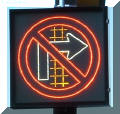

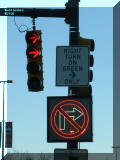
Signal used at the entrance to
Camden Yards for southbound vehicular traffic on Howard St. I'm not sure
if it uses fiber-optics or LEDS, as many of the pictures I took show the signal
in various stages of "lighting-up" -- in the right photo, you can see the tracks
are not illuminated, and in the center photo, there are still a few bits of
light showing.
This page was last modified on: 05/07/2007